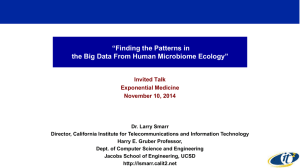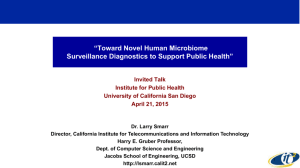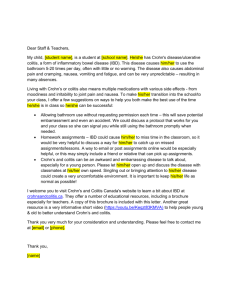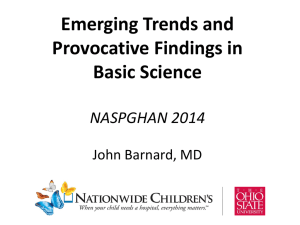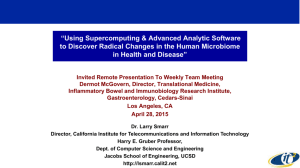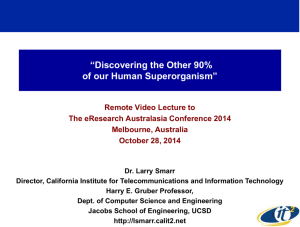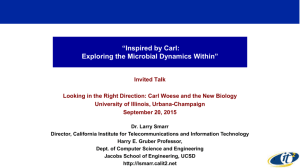PPT - Larry Smarr - California Institute for Telecommunications and
advertisement
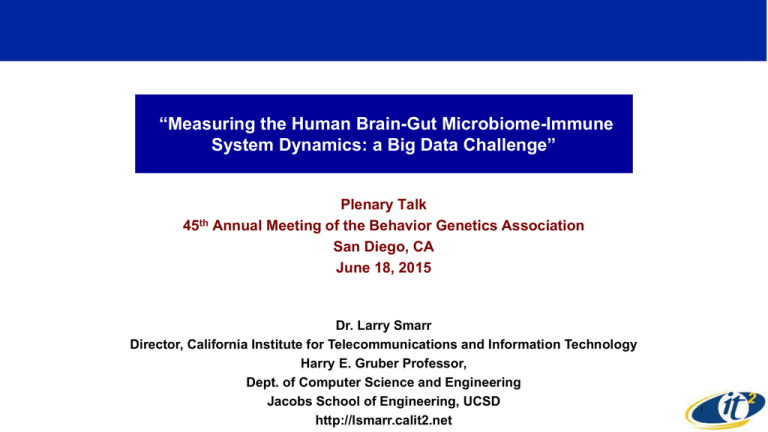
“Measuring the Human Brain-Gut Microbiome-Immune System Dynamics: a Big Data Challenge” Plenary Talk 45th Annual Meeting of the Behavior Genetics Association San Diego, CA June 18, 2015 Dr. Larry Smarr Director, California Institute for Telecommunications and Information Technology Harry E. Gruber Professor, Dept. of Computer Science and Engineering Jacobs School of Engineering, UCSD http://lsmarr.calit2.net 1 Interest in the Human Microbiome Has Moved Quickly From Frontier Science to Public Awareness June 8, 2012 June 14, 2012 June, 2012 August 18, 2012 To Understand the Interaction of Genetics and Human Behavior We Must Consider the Human Microbiome Your Body Has 10 Times As Many Microbe Cells As Human Cells Your Microbiome is Your “Near-Body” Environment and its Cells Contain 300x as Many DNA Genes As Your Human Cells The Microbiome–Gut–Brain Axis Provides New Systemic Insights into Shifts in Behavior and Disease Source: Montiel-Castro, et al. Frontiers in Integrative Neuroscience 2013 Many New Research Studies are Demonstrating Deep Relationships Between the Gut Microbiome and Behavioral Disorders Gut Microbes Regulate Serotonin Production, 90% of Which is in the Large Intestine “It's almost unthinkable that the gut is not playing a critical role in mind states," says gastroenterologist Emeran Mayer, MD, director of the Center for Neurobiology of Stress at UCLA Cell 161 264-276 (2015) How Can One Combine Human Genetic GWAS With Gut Microbiome Metagenomics and Immune System Dynamics? An N=1 Case Study of an Autoimmune Disease I Have Turned My Body into a Genomic and Biomarker Observatory Calit2 64 Megapixel VROOM One Blood Draw For Me Only One of My Blood Measurements Was Far Out of Range--Indicating Chronic Inflammation 27x Upper Limit Episodic Peaks in Inflammation Followed by Spontaneous Drops Normal Range <1 mg/L Complex Reactive Protein (CRP) is a Blood Biomarker for Detecting Presence of Inflammation Adding Stool Tests Revealed Oscillatory Behavior in an Immune Variable Which is Antibacterial Typical Lactoferrin Value for Active Inflammatory Bowel Disease (IBD) 124x Upper Limit for Healthy Normal Range <7.3 µg/mL Lactoferrin is a Protein Shed from Neutrophils An Antibacterial that Sequesters Iron I Turned to SNP Analysis and GWAS to Understand My Human Genomic Predispositions I Found I Had One of the Earliest Known SNPs Associated with Crohn’s Disease From www.23andme.com ATG16L1 IRGM NOD2 Polymorphism in Interleukin-23 Receptor Gene — 80% Higher Risk of Pro-inflammatory Immune Response rs1004819 SNPs Associated with CD There May Be a Correlation Between CD SNPs and Where and When the Disease Manifests NOD2 (1) Rs2066844 2.08x Increased Risk Subject with Ileal Crohn’s Female CD Onset At 20-Years Old Il-23R Rs1004819 1.8x Increased Risk Subject with Colonic Crohn’s Me-Male CD Onset At 60-Years Old Source: Larry Smarr and 23andme I Also Had an Increased Risk for Ulcerative Colitis, But a SNP that is Also Associated with Colonic CD I Have a 33% Increased Risk for Ulcerative Colitis HLA-DRA (rs2395185) I Have the Same Level of HLA-DRA Increased Risk as Another Male Who Has Had Ulcerative Colitis for 20 Years “Our results suggest that at least for the SNPs investigated [including HLA-DRA], colonic CD and UC have common genetic basis.” -Waterman, et al., IBD 17, 1936-42 (2011) So IBD May be Stratified by a Personalized Combination of the 163 Known SNP Loci Associated with IBD Could Changes in the Microbiome Ecology and Genetic Structure Provide Some of the Missing Variance? The width of the bar is proportional to the variance explained by that locus However, the Total Disease Variance Explained Is Only: • 13.6% for Crohn’s • 7.5% for Ulcerative Colitis “Host–microbe interactions have shaped the genetic architecture of inflammatory bowel disease,” Jostins, et al. Nature 491, 119-124 (2012) Why Did I Have an Autoimmune Disease like IBD? Despite decades of research, the etiology of Crohn's disease remains unknown. Its pathogenesis may involve a complex interplay between host genetics, immune dysfunction, and microbial or environmental factors. --The Role of Microbes in Crohn's Disease I Have Been Quantifying All Three Paul B. Eckburg & David A. Relman Clin Infect Dis. 44:256-262 (2007) The Genetic Distance Between Microbes Vastly Exceeds That Among All Animals and Plants You Are Here Tree of Life Derived from 16S rRNA Sequences Source: Carl Woese, et al For Deep Analysis of Changes in the Gut Microbiome Ecology Our Team Compared a Healthy Population with 3 Types of IBD Each Sample Has 100-200 Million Illumina Short Reads (100 bases) “Healthy” Individuals Inflammatory Bowel Disease (IBD) Patients 250 Subjects 1 Point in Time 2 Ulcerative Colitis Patients, 6 Points in Time Larry Smarr (Colonic Crohn’s) 7 Points in Time 5 Ileal Crohn’s Patients, 3 Points in Time Total of 27 Billion Reads Or 2.7 Trillion Bases Source: Jerry Sheehan, Calit2 Weizhong Li, Sitao Wu, CRBS, UCSD From Swedish Twin Study To Map Out the Dynamics of Autoimmune Microbiome Ecology Couples Next Generation Genome Sequencers to Big Data Supercomputers Example: Inflammatory Bowel Disease (IBD) We used 25 CPU-years to compute comparative gut microbiomes starting from 7 trillion DNA bases of my samples, 255 healthy, and 20 IBD controls Illumina HiSeq 2000 at JCVI SDSC Gordon Data Supercomputer Computational NextGen Sequencing Pipeline: From Sequence to Taxonomy and Function PI: (Weizhong Li, CRBS, UCSD): NIH R01HG005978 (2010-2013, $1.1M) When We Think About Biological Diversity We Typically Think of the Wide Range of Animals But All These Animals Are in One SubPhylum Vertebrata of the Chordata Phylum All images from Wikimedia Commons. Photos are public domain or by Trisha Shears & Richard Bartz Think of These Phyla of Animals When You Consider the Biodiversity of Microbes Inside You Phylum Chordata Phylum Cnidaria Phylum Echinodermata Phylum Annelida Phylum Mollusca Phylum Arthropoda All images from WikiMedia Commons. Photos are public domain or by Dan Hershman, Michael Linnenbach, Manuae, B_cool We Found Major State Shifts in Microbial Ecology Phyla Between Healthy and Three Forms of IBD Average HE Most Common Microbial Phyla Average Ulcerative Colitis Average LS Colonic Crohn’s Disease Average Ileal Crohn’s Disease Explosion of Proteobacteria Hybrid of UC and CD High Level of Archaea Collapse of Bacteroidetes Explosion of Actinobacteria Dell Analytics Separates The 4 Patient Types in Our Data Using Our Microbiome Species Data Ulcerative Colitis Colonic Crohn’s Healthy Ileal Crohn’s Source: Thomas Hill, Ph.D. Executive Director Analytics Dell | Information Management Group, Dell Software I Built on Dell Analytics to Show Dynamic Evolution of My Microbiome Toward and Away from Healthy State – Colonic Crohn’s Seven Time Samples Over 1.5 Years Healthy Colonic Crohn’s Ileal Crohn’s This Year We Will Extend My Stool Time Series Collaborating with the UCSD Knight Lab Larry’s 40 Stool Samples Over 3.5 Years to Rob’s lab on April 30, 2015 Time Series Reveals Behavior Changes (Depression, Malaise) Associated with Time Progression of Autoimmune Disease Immune & Inflammation Variables 2009 2010 2011 2012 2013 2014 2015 Weekly Symptoms Mood Disorders Pharma Therapies Stool Samples In a “Healthy” Gut Microbiome: Large Taxonomy Variation, Low Protein Family Variation Over 200 People Source: Nature, 486, 207-212 (2012) We Computed the Relative Abundance of Microbial Gene Families ~10,000 KEGG Orthologous Genes, Across Healthy and IBD Subjects How Large is the Microbiome’s Genetic Change Between Health and Disease States? Ratio of One of the Healthy Subjects to the Average KEGG for 35 Healthy: Test to see How Much Inter-Personal Variation There is Within Healthy Ratio of Random HE11529 to Healthy Average for Each Nonzero KEGG We Computed the Relative Abundance of 10,000 KEGGs in 35 Healthy And 25 IBD Patients Most KEGGs Are Within 10x Of Healthy for a Random HE Nonzero KEGGs However, Our Research Shows Large Changes in Protein Families Between Health and Disease Ratio of CD Average to Healthy Average for Each Nonzero KEGG KEGGs Greatly Increased In the Disease State Note Hi/Low Symmetry Note 700 KEGGs With Ratio >10 Most KEGGs Are Within 10x In Healthy and Ileal Crohn’s Disease Note 1000 KEGGs With Ratio <0.1 KEGGs Greatly Decreased In the Disease State Over 7000 KEGGs Which Are Nonzero in Health and Disease States Next Step: Compute Genes and Function For All ~300 People’s Gut Microbiome Full Processing to Function: Genes & Protein Families (COGs, KEGGs) Would Require ~1-2 Million Core-Hours UC San Diego Will Be Carrying Out a Major Clinical Study of IBD Using These Techniques Announced November 7, 2014! Inflammatory Bowel Disease Biobank For Healthy and Disease Patients Already 185 Enrolled Drs. William J. Sandborn, John Chang, & Brigid Boland UCSD School of Medicine, Division of Gastroenterology We Must Move From Combating Single Microbe Diseases to Developing the Human/Microbiome System Approach to Public Health Bach (2002) N Engl J Med, Vol. 347, 911-920 2014 For Public Health It is Still About Microbes, But from Single Species to Entire Ecologies The United States Population’s Human Gut Microbiome Has Diverged a Great Deal from Hunter-Gatherers [Amerindians in Venezuela/Columbia] [Africa] Missing Microbes Human Microbiome Project “The microbiome of uncontacted Amerindians,” J. C. Clemente, et al. Science Advances 1, e1500183 (2015). The Coupled Neural, Immune, and Microbiome Systems Provide a Model Explaining How Nutrition Can Alter Neurodevelopment Thanks to Our Great Team! UCSD Metagenomics Team JCVI Team Weizhong Li Sitao Wu Karen Nelson Shibu Yooseph Manolito Torralba Calit2@UCSD Future Patient Team SDSC Team Jerry Sheehan Tom DeFanti Kevin Patrick Jurgen Schulze Andrew Prudhomme Philip Weber Fred Raab Joe Keefe Ernesto Ramirez Dell/R Systems Ayasdi Devi Ramanan Pek Lum Michael Norman Mahidhar Tatineni Robert Sinkovits Brian Kucic John Thompson UCSD Health Sciences Team Rob Knight William J. Sandborn Elisabeth Evans John Chang Brigid Boland David Brenner
